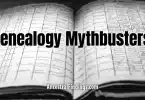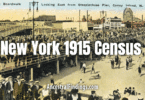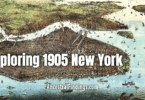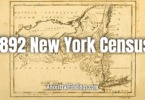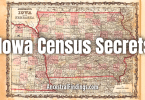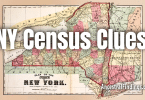The 1925 New York State census holds a prominent place in the lineup of state enumerations. This is not only because it was the last one conducted by the state but also because of the historical moment it captured. Taken just five years before the 1930 federal census, the 1925 enumeration offers researchers a final glimpse of New York families as they transitioned from the post–World War I years into a new, modern era marked by rapid change.
By the mid-1920s, New York State had evolved into a complex and dynamic region, shaped by industrial expansion, immigration, and cultural shifts. Therefore, the 1925 census becomes an indispensable resource for those seeking to understand the people and communities during this pivotal period.
What Was Happening in 1925?
The 1920s were roaring for a reason. The end of World War I in 1918 ushered in a period of economic optimism and social transformation. New York, already a melting pot of cultures, continued to absorb immigrants from Europe. However, this occurred at a slower pace due to the restrictive Immigration Act of 1924, which set quotas based on national origin.
This decade saw the rise of the Jazz Age, the spread of consumer culture, and significant improvements in transportation and infrastructure. Automobiles, radios, and motion pictures were changing how people lived, worked, and socialized. Prohibition, instituted in 1920, brought with it not only moral debates but also the rise of organized crime and underground speakeasies, especially in urban centers.
In short, life in 1925 was modernizing rapidly. The census helps capture who was living through these changes and how they were affected by them.
Why the 1925 Census Matters for Family History
The 1925 census is a vital tool for researchers focused on this transitional period. It provides the opportunity to:
- Place individuals between the 1920 and 1930 federal censuses
- Examine household compositions that changed in the post-war years
- Study early 20th-century migration trends, especially from rural areas to cities
- Discover clues about employment, community structures, and evolving family roles
For people who lost relatives between 1920 and 1930, the 1925 census can offer the only confirmation of their presence during that decade. It also provides a touchpoint for identifying older generations who may not have made it to 1930. Additionally, it helps identify younger generations born between federal enumerations.
What Information Does the 1925 Census Include?
While it doesn’t go into as much detail as federal censuses, the 1925 New York State census still provides a significant amount of useful data:
- Full name of each person
- Relationship to the head of household
- Age
- Sex
- Color or race
- Country or state of birth
- Citizenship status for foreign-born individuals
- Occupation
- Residence (by street and house number in cities)
Just as in the 1905 and 1915 state censuses, the 1925 version offers a snapshot of urban life. This data is particularly useful for understanding apartment dwellers, boarding houses, and dense immigrant neighborhoods. In rural regions, you’ll see large families, farm laborers, and evidence of regional industries that shaped local economies.
How It Helps Fill the Gaps
One of the primary uses of this census is bridging the gap between the 1920 and 1930 federal censuses. This is especially crucial when vital records or obituaries are missing. If an individual disappears from the 1930 records but appeared in 1920, checking the 1925 enumeration helps determine whether they moved, died, or perhaps changed names due to marriage or remarriage.
Because the 1925 census includes citizenship status and occupation, it can also direct researchers to naturalization records or employment-based archives. For example, a foreign-born machinist in Brooklyn may have worked at a known factory. His presence in 1925 could help determine whether he gained citizenship before or after this date.
A Closer Look at Occupation and Location
Employment listed in the census can offer clues about social standing and economic conditions. Was the individual a streetcar conductor? A clerk in a department store? A laborer in a steel mill? These roles tell stories not just about income, but about workplace environments, union membership, and possible community ties.
Addresses, especially in cities, are often very precise. Researchers can use these to pull up maps, city directories, and even property records. For example, an ancestor living at a certain Bronx address in 1925 may appear in a Sanborn fire insurance map. This provides visual context to their neighborhood and home.
Finding the Records
You can find the 1925 New York State census at several key repositories:
- FamilySearch.org (free access to images; some locations indexed)
- Ancestry.com (fully indexed and searchable with images)
- New York State Archives (microfilm copies and limited digitization)
- County historical societies and libraries (some have extracted or transcribed census data)
Because handwriting and indexing errors are common, researchers are encouraged to browse by location when name searches don’t yield results. Knowing a district or street from city directories can dramatically reduce search time.
Historical Context Matters
The census on its own is useful, but understanding what was happening at the time adds deeper meaning. In 1925, the Harlem Renaissance was flourishing, particularly in New York City. Black Americans migrating from the South were making new homes in urban areas and contributing to a profound cultural moment in U.S. history.
Women had gained the right to vote just a few years earlier in 1920. By 1925, many were entering the workforce in greater numbers. Therefore, they started showing up in census records not only as homemakers but also as teachers, stenographers, nurses, and sales clerks.
The labor landscape was shifting as well. Though the Great Depression hadn’t yet begun, many were already experiencing inequality and instability in employment. The census can be a lens to explore these challenges through the occupations recorded.
Using It for Ethnic and Immigration Research
This census is a goldmine for those researching immigrants and ethnic communities. While the 1924 Immigration Act severely restricted new arrivals, many who came earlier were still settling in. Researchers can trace names, ages, and occupations of Italian, Polish, Jewish, Irish, German, and other immigrant families. These families were clustered in boroughs, mill towns, or farming enclaves.
The 1925 census also provides a last glance at multi-generational immigrant households, before younger generations began assimilating further, changing names, and moving to suburban communities.
Challenges in Research
As with all handwritten documents, the usual issues apply:
- Name variations and misspellings
- Difficult handwriting
- Incomplete or faded microfilm
Cross-referencing with other records—such as draft registrations, city directories, or church registers—can help confirm identities.
Final Thoughts: A Fitting Close to New York’s State Census Tradition
The 1925 New York State census marks the end of an era. It was the final statewide enumeration before the practice was discontinued. Yet despite being the last, it remains one of the most informative, thanks to its placement in history and the richness of detail it offers.
For those building timelines, seeking relatives lost to history, or hoping to understand their family’s part in the American story during the 1920s, this census provides a valuable snapshot. It stands as a strong conclusion to New York’s unique mid-decade census tradition. Moreover, it serves as a powerful entry in our ongoing Lost In Between series.
These are the records that remind us: the more often we find our ancestors in time, the clearer their stories become.

